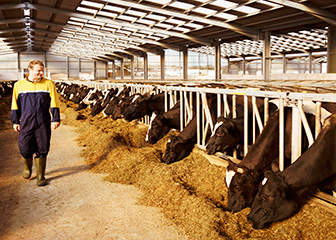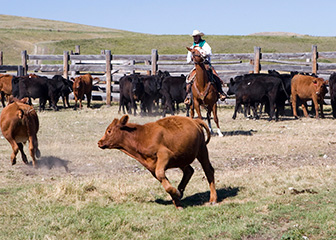What Farmers, Ranchers, and Other Agricultural Managers Do
About this section

Some farmers work primarily with crops and vegetables, whereas other farmers and ranchers handle livestock.
Farmers, ranchers, and other agricultural managers run establishments that produce crops, livestock, and dairy products.
Duties
Farmers, ranchers, and other agricultural managers typically do the following:
- Supervise all steps of the crop production and ranging process, including planting, fertilizing, harvesting, and herding
- Determine how to raise crops or livestock according to factors such as market conditions, federal program availability, and soil conditions
- Select and purchase supplies, such as seed, fertilizers, and farm machinery
- Operate and repair farm machinery so it cultivates, harvests, and hauls crops
- Adapt what they do as needed for weather and where the crop is in its growing cycle
- Maintain farm facilities, including its water pipes, hoses, fences, and animal shelters
- Serve as the sales agent for livestock and crops
- Keep financial, tax, production, and employee records
American farmers, ranchers, and other agricultural managers produce enough food and fiber to meet the needs of the United States and for export. However, farm output and income are strongly influenced by weather, disease, fluctuations in prices, and federal farm programs.
Farmers, ranchers, and other agricultural managers monitor the constantly changing prices for their product. They use different strategies to protect themselves from unpredictable changes in the markets.
Many farmers carefully plan the combination of crops that they grow, so if the price of one crop drops, they will have enough income from another crop to make up the loss. When farmers and ranchers plan ahead, they may be able to store their crops or keep their livestock to take advantage of higher prices later in the year.
Most farm output goes to food-processing companies. However, some farmers now choose to sell their goods directly to consumers through farmer's markets or use cooperatives to reduce their financial risk and gain a larger share of the final price of their goods. In community-supported agriculture, cooperatives sell shares of a harvest to consumers before the planting season to ensure a market for the farm's produce.
Farmers, ranchers, and other agricultural managers also negotiate with banks and other credit lenders to get financing because they must buy seed, livestock, and equipment before they have products to sell.
Farmers and ranchers own and operate mainly family-owned farms. They also may lease land from a landowner and operate it as a working farm.
The size of the farm or range determines which tasks farmers and ranchers handle. Those who operate small farms or ranges usually do all tasks. In addition to growing crops and raising animals, they keep records, service machinery, and maintain buildings.
Those who operate large farms, however, have employees—including agricultural workers— who help with physical work. Some employees of large farms are in nonfarm occupations, working as truck drivers, sales representatives, bookkeepers, and IT specialists.
Both farmers and ranchers operate machinery and maintain their equipment and facilities. They track technological improvements in animal breeding and seeds, choosing new products that might improve output.
Agricultural managers take care of the day-to-day operation of one or more farms, ranches, nurseries, timber tracts, greenhouses, or other agricultural establishments for corporations, farmers, or owners who do not live and work on their farm or ranch.
Agricultural managers usually do not do production activities themselves. Instead, they hire and supervise farm and livestock workers to do most daily production tasks.
Managers may determine budgets. They may decide how to store and transport the crops. They oversee proper maintenance of equipment and property.
The following are some types of farmers, ranchers, and other agricultural managers:
Crop farmers and managers—those who grow grain, fruits and vegetables, and other crops—are responsible for all steps of plant growth. After a harvest, they make sure that the crops are properly packaged and stored.
Livestock, dairy, and poultry farmers, ranchers, and managers feed and care for animals. They keep livestock in barns, pens, and other well-maintained farm buildings. These workers also oversee breeding and marketing.
Horticultural specialty farmers and managers oversee the production of fruits, vegetables, flowers, and plants (including turf) used for landscaping. They also grow grapes, berries, and nuts used in making wine.
Aquaculture farmers and managers raise fish and shellfish in ponds, floating net pens, raceways, or recirculating systems. They stock, feed, protect, and maintain aquatic life used for food and for recreational fishing.








